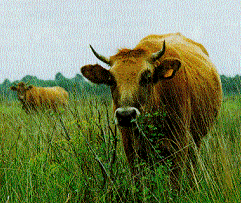 The James Hutton Institute
The James Hutton Institute
This page is no longer updated. The Macaulay Land Use Research Institute joined forces with SCRI on 1 April 2011 to create The James Hutton Institute.

The changes in the CAP from production-orientated agricultural support measures towards direct agri-environment support is stimulating research across the EU investigating the important relationships between farming systems and environmental impact.
This area of activity is especially important in relation to the marginal agricultural areas (Lecompte, 1994). The hills, uplands and wetlands of Europe comprise a large proportion of the rich environmental resources that are crucial to protect. Previous agricultural policies have, at times, caused harm in these areas by encouraging inappropriate intensification, ploughing of unproductive land, high stocking densities, etc. at the expense of the indigenous wildlife and vegetation and increased pollution and land degradation. Rural poverty leading to rural depopulation has also contributed significantly to environmental degradation and a loss of habitats which are dependant on some level of management for their survival.
A number of current CAP incentives and national support programmes have been designed to encourage the countryside stewardship role of farmers. A major component of this has been the active use of livestock for the restoration and management of the rich and diverse habitats of marginal areas across Europe (Milne, 1994).
In a number of research projects in the EU, the functional relationships between grazing livestock and the environment are being quantified. For example, grazing ecology research has demonstrated the interactions between ruminants and vegetation dynamics for improved and semi-natural vegetation and the effects of different vegetation types on animal performance.
This approach is at the heart of landscape management research and it is of crucial importance that progress in this field is effectively reported to livestock production systems developers and policy researchers in order to aid the integration of grazing ecology principles into new, sustainable livestock systems which are profitable and have a positive role in habitat creation and management.
 Vegetation management is becoming increasingly important in Mediterranean regions where the prevention of forest fires is an urgent priority. A major contributory factor to the increase in fire risk has been the accumulation in many areas of dry combustible vegetation due to recent underutilisation by domestic livestock. Current research in France, Spain, Italy and Greece has demonstrated the important role in reducing the amount of combustible material that extensive systems of domestic ruminants, particularly goats, could
play.
Vegetation management is becoming increasingly important in Mediterranean regions where the prevention of forest fires is an urgent priority. A major contributory factor to the increase in fire risk has been the accumulation in many areas of dry combustible vegetation due to recent underutilisation by domestic livestock. Current research in France, Spain, Italy and Greece has demonstrated the important role in reducing the amount of combustible material that extensive systems of domestic ruminants, particularly goats, could
play.
It is important, however, that the environmental hazards of domestic livestock are also considered. Overstocking can be a significant cause of land degradation, erosion and consequent river pollution.
A network will be established of scientists studying plant-animal interactions, landscape management and landscape ecology in order to:
· Explore new opportunities for synergy between environmental and agricultural activities;
· Define habitat management objectives for livestock systems in disadvantaged areas across Europe;
· Audit developments in livestock systems research to ensure compatibility with environmental objectives in disadvantaged areas;
· Disseminate information on landscape and habitat management to the other sub-groups.
The dissemination between subgroups will take place through the workshops and via the Newsletter. Sub-groups will contain approximately 10 researchers each, specifically working on disadvantaged areas throughout the European Union.